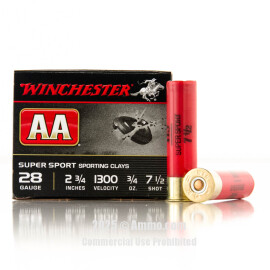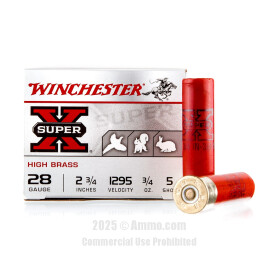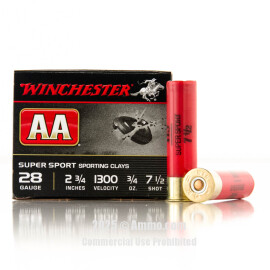
28 Gauge Shotgun Shells For Sale
Overview of 28 Gauge Shotgun Shells
While over a hundred years old, the 28 gauge shotgun shell is the up-and-coming round in the shotgun world. It’s used in skeet shooting and upland bird hunting and provides a valuable alternative to the traditional.
Although not as popular as other small-bore shotgun shells, the 28 gauge is capable, effective, and easy to shoot. It continues to grow in popularity, and more shooters find a use for it year after year, primarily due to the instinctual way firearms chambered for the round fire.
How Does The 28 Gauge Compare To Other Shotgun Gauges?
| Gauge | Recoil | Pros | Cons |
|---|---|---|---|
| .410 Bore | 28 Gauge has more | 28 Gauge has more stopping power and more pellets on target | 28 Gauge has heavier recoil |
28 Gauge Ballistics: Chart of Average 28 Gauge Ballistics
Note: This information comes from the manufacturer and is for informational purposes only. The actual ballistics obtained with your firearm can vary considerably from the advertised ballistics. Also, ballistics can vary from lot to lot with the same brand and type load.
| Shell Length | Shot Ozs. | Shot Sizes | Load Style | Dram Equivalent | Velocity (fps) |
|---|---|---|---|---|---|
| 3" | 7/8 | 4, 5, 2006 | Tundra Tungsten | Max | TBD |
| 2-3/4" | 1 | 6, 7-1/2, 8 | High Velocity | 2 | 1125 |
| 3/4 | 6, 7-1/2, 8, 9 | High Velocity | 2-1/4 | 1295 | |
| 3/4 | 8, 9 | Target | 2 | 1200 | |
| 3/4 | 7-1/2, 8-1/2 | Sporting Clays | Max | 1300 | |
| 3/4 | 5, 7 | Bismuth | Max | 1250 | |
| 5/8 | 6, 7 | Steel | Max | 1300 | |
| 5/8 | n/a | Slug | Max | 1450 |
Customer Reviews
-
Fred Flintstone said:
I got a good deal in Mesa buying three flats. It shoots well, However I have such a hard time reloading the spent hulls. I find the Winchester AA HS and the Federal Top Gun is much easier. Also I have had the Fiocchi hulls blow in half after about the third or 4th reload. I use the 20/28 and the 572 powder. Don't know if this is a factor, but is my experience!
-
Dick said:
Have no compliants Performed better than expected
-
Na said:
Had to purchase by box instead of flat price but other than that couldn't ask for a better company to purchase ammo from prompt shipping and always receiving what was ordered to genuine mission to protect 2A tights. My ammo supplier of choice.






























